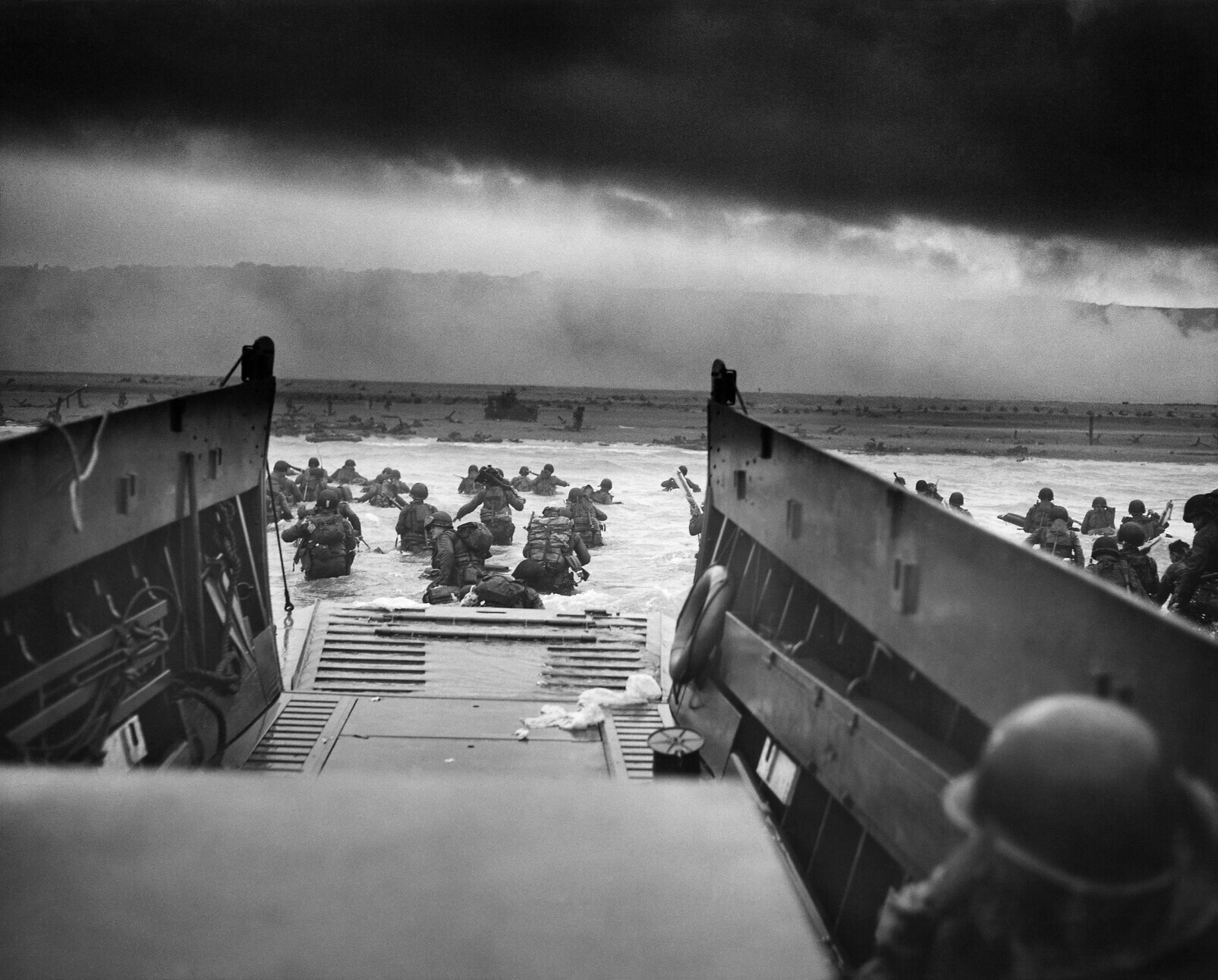“A group of anti-fascists disrupting a white supremacist gathering”
I was struck by the ingenuity of the heading over this photograph in my Mastodon feed. The person who posted it (@miriamm@mastodon.social) added this explanation:
The photograph titled “Taxis to Hell – and Back – Into the Jaws of Death” encapsulates a moment of great courage and selflessness during one of the most pivotal events of the 20th century. Taken on June 6, 1944, known as D-Day, during the Allied invasion of Normandy, the picture depicts a group of American soldiers as they storm the beaches of Omaha under heavy German fire.
The photographer, Robert F. Sargent, was a member of the United States Coast Guard assigned to document the invasion. He and his camera crew landed on the beach with the first wave of troops. The soldiers in the photograph were members of the 16th Infantry Regiment of the 1st Infantry Division, nicknamed the “Big Red One,” tasked with securing a stretch of beach codenamed “Easy Red.”
The amphibious tanks were swamping off the beaches, making the journey even more perilous. The soldiers endured the bitter cold and drenching waves that constantly broke over the vessel. As they approached Omaha Beach, the incoming tide and the German obstacles, which were meant to hinder the Allied invasion, were visible. Sargent observed a disabled amphibious tank and another landing craft that had broached along the beach, just as their landing craft was preparing to lower the bow ramp. Despite the German artillery targeting their landing craft, they managed to discharge all the troops into chest-deep water without any casualties. However, he also witnessed another landing craft positioned close to their port side, which was not as fortunate.
Quote of the Day
”If a lion could talk we would not understand him.”
- Ludwig Wittgenstein, in his Philosophical Investigations.
Musical alternative to the morning’s radio news
Count Basie Orchestra | “Lil Darlin”
Long Read of the Day
Something Broke! The Silicon Valley Bank Failure How tech hubris and low interest rates combined to produce a big mess.
Terrific blog post by Adam Tooze on the implosion of the Valley’s favourite bank. It’s the best explanation I’ve seen of how SVB imploded. Interestingly, many (most?) of its depositors were tech start-ups which used the bank to park their VC-provided funds while they were getting organised.
Given the prevalence of libertarian ideology in the Valley, chances are that some of those depositors were ardent believers in the idea of reducing the State to the point (as Grover Norquist, one of their more fanatical brethren once put it, “it could be drowned in a bathtub”).
Now comes an intriguing question. In the US, deposits of $250,000 or less in a failed bank are protected by the government. My guess is that most of those deposits in SVB exceeded that sum. Stand by, therefore, for the pathetic wails and pleas of libertarian investors for help — from the government they have, to date, been unable to drown in said bathtub.
The hypocrisy involved will not be exhibited only by depositors. As Tooze points out, SVB was not stress-tested by regulators. Why not?
Because in 2018 the regulations were changed and SVB was leading the charge pushing for the onerous regulations to be lifted.
The executive who led the lobbying charge, one Greg Becker, was — according to Business Standard — the same Greg Becker who
“sold $3.6 million of company stock under a trading plan less than two weeks before the firm disclosed extensive losses that led to its failure. The sale of 12,451 shares on Feb. 27 was the first time in more than a year that Becker had sold shares in parent company SVB Financial Group, according to regulatory filings. He filed the plan that allowed him to sell the shares on Jan. 26.”
Users, advertisers – we are all trapped in the ‘enshittification’ of the internet
Yesterday’s Observer column:
Those whom the Gods wish to destroy,” says the adage, “they first make mad.” Actually, that’s overkill: the Gods just need to make people forget. Amnesia turns out to be a powerful narcotic and it’s been clouding our perceptions of what’s been happening on the internet for at least 25 years, namely the inexorable degradation of the online environment and our passive, sullen acceptance of that.
Thanks to Cory Doctorow, the great tech critic, we now have a term for this decay process in online platforms – enshittification. “First,” he writes, “they are good to their users; then they abuse their users to make things better for their business customers; finally, they abuse those business customers to claw back all the value for themselves.” Enshittification results from the convergence of two things: the power of platform owners to change how their platforms extract value from users and the nature of the two-sided markets – where the platforms sit between buyers and sellers, holding each hostage to the other and then raking off an ever-larger share of the value that passes between them…
Do read the whole thing
Books, etc.
If you drive (as we often do) across the Fens from Cambridge to Ely, there comes a wonderful moment when suddenly the silhouette of Ely Cathedral appears on the horizon and one appreciates why in medieval times it was known as “the Ship of the Fens”. When viewing it from close up, though, the thought that never fails to come to mind is of the immense power, wealth and resources that were needed to create such a monument in the Middle Ages.
This is true for all of the great cathedrals of Europe, which is why the arrival of a new book about their construction is interesting. Matthew Lyons has a nice review of it in The Critic magazine.
This Blog is also available as a daily email. If you think that might suit you better, why not subscribe? One email a day, Monday through Friday, delivered to your inbox. It’s free, and you can always unsubscribe if you conclude your inbox is full enough already!


